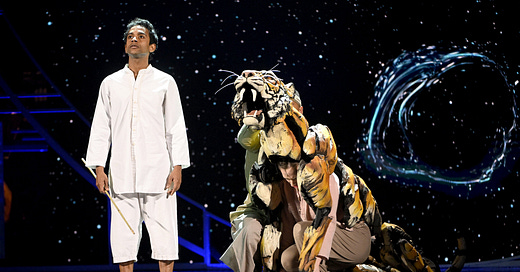It’s easy to see how Yann Martel’s 2001 novel The Life of Pi became the book of that particular moment. An allegorical novel all about proof of a higher power as so many were brought under the shadow of terrorism and impending war was all the more welcome for its seeming simplicity. A shipwrecked boy is trapped in a lifeboat with a tiger. Martel’s book was just enough of everything to appeal to nearly everyone--philosophical without being verbose, profound without being pretentious, and hopeful without being hackey.
It appeared on numerous “Best of the Year” lists and a decade later, Ang Lee directed a feature film version that sadly does not feature some of the best CGI you’re likely to see, but he won an Oscar for the effort nonetheless.
Now, a stage version has arrived at American Repertory Theater in Cambridge. A prior version in England by Keith Robinson was performed with a small crew of actors performing all the roles. The adaptation arriving stateside before transferring to Broadway (ART’s second transfer in under a year after their production of 1776) is adapted by Lolita Chakrabarti, the playwright behind the absolutely incredible play Red Velvet, and directed by Max Webster with puppet design by Nick Barnes and Finn Caldwell and puppet and movement direction by Caldwell, who I hope will be singled out when the play reaches New York for the show stopping work he does with Richard Parker, the tiger trapped in the lifeboat.
Whenever a show relies on any kind of spectacle, the question that must be asked is whether or not it could survive without whatever flash it has in the pan. In this case, the play suffers from what happens with most musical adaptations--We get to the good part far too late. It isn’t until nearly intermission when the ship goes down in a storm. Up to that point, we’ve spent a sizable amount of time getting to know Pi (played by the charming Adi Dixit), his life at his family’s zoo in Pondicherry, India, and his quest to love God. The latter involves a sampling of three different religions. Chakrabarti has to find a way to theatricalize the existential parts of the novel, and while anyone would struggle with this, she gets bogged down in a scene that goes on far too long and fails to resonate. Unfortunately, the production has been marketed as fun family theater with puppets (Everybody loves puppets!) and so you can feel the audience shifting uncomfortably when they start to wonder why they’re listening to a bunch of characters go on about the pros and cons of different religions. Twenty years ago, there might have been an expectation that the audience have a familiarity with this story, but even the film is a decade old, and at this point, I think it’s safe to say people are coming to it with fresh eyes. That’s an exciting opportunity for those working on it since an argument could be made that a story that already has a celebrated novelization and an acclaimed film really didn’t need to be made into a play, but then again look at--
:: Motions to Everything Else ::
The difficulty doesn’t just lie in the intangible portions of the book. The story has also--ironically--come under the influence of the British in ways that are not ideal. For every Curious Incident of the Dog in Nighttime, there’s a show that’s made overly presentational in a way that distances the audience from the narrative. Life of Pi is an experience that needs to be felt as intimately as possible. While the venue for this production is perfect for that intimacy, everyone on stage is playing the tale as far and broad as possible. That’s not the result of bad acting, as many of the performers are quite good (Rajesh Bose and Mahira Kakkar are excellent as Pi’s parents), but the way the play insists on being a play for children rather than a play with a child at its center. By the time we’re made aware that this is very much a story for grown-ups, it becomes unclear why everything has been dressed up in such pageantry.
If a show has giant puppets running around onstage, the acting and dialogue need to be as realistic as possible to ground the story or risk it from running over into farce. Dixit manages to find a balance within his character, but the rest of the cast isn’t as successful.
While the scenic and costume design by Tim Hatley and the lighting design by Tim Lutkin are stunning to behold, they become one element that overshadows the storytelling. The deep, soul-rattling takeaway we’re supposed to leave the theater with never arrives, because the violence within the narrative fits the presentation far better than the optimism does.
Life of Pi is still, in many ways, an exhilarating evening of theater, if only to see fine artsmanship at work every time one of the animals leaps onto the stage.
It’s when we’re asked to fill in the gaps between those moments that the ship begins to sink.



